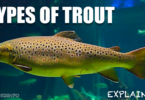Scomberomorus maculatus, commonly known as Spanish mackerels, is a fascinating fish species that has captured the eyes of anglers and fishermen for a long time. Their silvery appearance, sleek body, impressive speed, and agility in the water make them highly prized fish in the seafood industry. This article will provide a guideline about the Spanish mackerels and explore more about their lifestyle.
What is the Scientific Classification of the Spanish Mackerels?
The scientific classification of the Spanish Mackerel (Scomberomorus maculatus) is as follows:
- Kingdom: Animalia
- Phylum: Chordata
- Class: Actinopterygii
- Order: Perciformes
- Family: Scombridae
- Genus: Scomberomorus
- Species: maculatus
What is the Habitat and Distribution of the Spanish Mackerels?
Spanish mackerels are found living in the warm waters of the Atlantic Ocean, along the Eastern coast of the United States, the Caribbean Sea, and the Gulf of Mexico. These species prefer coastal waters, usually near the shorelines, or around structures like piers, jetties, and artificial reefs. They exhibit migratory behavior, moving southward as the temperature drops and towards northward as the temperature rises, however, the ideal temperature for the Spanish mackerels to thrive is between 68° and 86°F.
What Are the Physical Features of the Spanish Mackerels?
They have slender, torpedo-shaped bodies with striking blue-green backs, silversides, and rows of olive-to-yellow spots on both sides. They have a forked tail, two dorsal fins, and a mouth filled with sharp teeth, marking them an efficient and skilled hunter of the ocean. The Spanish mackerels can grow to an average length of 12 to 24 inches and weigh around 2 to 3 pounds. However, the largest specimen ever caught can measure about 36 inches in length and weighs 13 pounds and 12 ounces.
What is the Feeding Habitat of the Spanish Mackerels?
Spanish mackerel feeds on a range of fish species, squid, and prawns. They are skilled hunters thanks to their amazing speed and agility, which help them to chase down schools of fish. They have sharp and serrated teeth which allow them to catch and swallow the prey whole or in pieces. They hunt their food in a frenzied manner near the surface, producing an impressive show.
What is the Reproductive Behavior of Spanish Mackerels?
The spawning season of Spanish mackerels occurs during the warmer months of late spring to summer when water temperatures are suitable for reproduction. The male and female mackerels release sperm and eggs in the water for fertilization. The eggs, after being fertilized, float near the surface and are carried by a water current, dispersing the larvae and reducing the competition among siblings. The eggs typically hatch within a day or two after fertilization. Once hatched, they spend the early part of their life drifting in the open ocean, and as they grow, Spanish mackerel undergo a transition from the larval stage to juvenile fish.
What is the Conservation Status of Spanish Mackerels?
Well, the conservation status of Spanish mackerels changes with time, depending upon their location and the local management approaches. These species face great threats due to habitat degradation and overfishing in their natural habitat. Therefore, sustainable fishing practices and the implementation of strict regulations are necessary to ensure their long-term survival in the open waters.
Interesting Facts About Spanish Mackerels
Some of the fun facts about the Spanish mackerels are narrated below:
- When hunting prey, Spanish mackerel are renowned for their sudden bursts of speed, frequently reaching speeds of up to 40 miles per hour.
- They are opportunistic eaters who frequently scavenge on the remains of bigger predators like sharks or dolphins.
- Spanish mackerel are schooling fish, and when they become too hungry, it is referred to as a “bust”.
- Water temperature affects their migratory habits, with warmer seas luring them in throughout the winter.
- Spanish mackerel often live for 5 to 10 years.
Conclusion
The remarkable biology, migratory patterns, habitat, feeding, and reproductive patterns, mark the Spanish mackerels as a fascinating species to study and appreciate. However, these species are facing significant threats in their natural habitat which is why their population has been greatly declining. Therefore, we can ensure that future generations may continue to enjoy the beauty and flavors that Spanish mackerel provide to our seas by maintaining their species as well as their environment.







